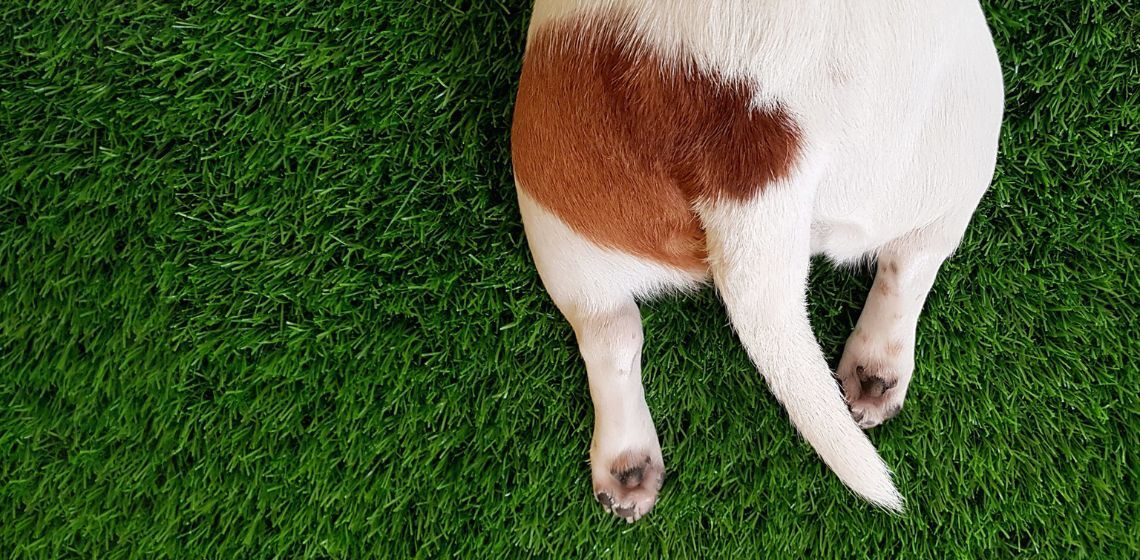Table of Contents
Seeing a dog wag its tail joyfully often makes us smile. But did you know a dog can cause tail damage by wagging it against hard surfaces?
A happy tail syndrome is a painful condition that occurs when a dog damages its tail by hitting it with enough force that it causes the thin skin on the tail tip to tear. Treatment is often frustrating and recurrence is common, so having pet insurance is certainly worth it. If this wound cannot be treated successfully with bandaging, surgical tail amputation may be necessary if there is further trauma.
Keep reading to learn more about how to treat happy tail syndrome, including symptoms, affected breeds, and treatment options.
What Is Happy Tail Syndrome in Dogs?
“Happy tail syndrome” is unfortunately not as joyful as it sounds. While this condition starts with a happy dog wagging his tail, it can result in a recurring and frustrating source of pain for the dog and its owner. Happy tails occur when a dog damages his own tail by hitting it against hard objects.
What Are the Symptoms of Happy Tail Syndrome?
Dogs affected by happy tail syndrome experience symptoms affecting the tip of their tails. Symptoms include bleeding, crusting or scabbing, and hair loss. The bleeding is usually not significant and is often intermittent. Because the condition occurs when a dog wags its tail against hard surfaces, an owner may see blood on the walls of a dog’s crate or kennel.
It is easier to see on short-haired dogs than on smaller dogs with thicker fur, so it is important that you check on your pet, especially if tail biting starts.
Symptoms should be localized to a dog’s tail. Dogs with happy tails should not have systemic signs of illness as long as they do not have any other concurrent health problems. There should be no changes to appetite, thirst, energy level, urination, or defecation.
If you believe your dog has the happy tail syndrome, please consult your veterinarian. And if your dog also has systemic signs of illness, it is even more crucial to seek immediate veterinary care.
What Causes a Happy Tail?
A happy tail is caused by a dog slamming its tail repeatedly against a hard surface. Dogs are more prone to developing this syndrome if they are confined to a small space such as a crate or kennel. Therefore, this condition may be seen after boarding or traveling with your pet.
There seems to be a breed predisposition associated with a happy tail. Large breed dogs or working breeds can wag their tails more forcefully. Additionally, dogs with skinny long tails without a lot of fur padding are more likely to damage their tails. Therefore, this syndrome is commonly seen in Pit Bulls, Shepherds, Labrador Retrievers, Greyhounds, and Great Danes.
Happy tail is usually diagnosed based on the dog’s history (e.g. recent boarding), breed, and symptoms. However, if your dog’s tail is bleeding, it is important to rule out other potentially more serious underlying causes such as a bleeding disorder. For example, your veterinarian may perform bloodwork to ensure your dog does not have anemia or a low platelet count.
Happy Tail Syndrome Treatment
If your dog has the happy tail syndrome, it is crucial to set realistic expectations about treatment success. With any type of wound, the healing process is often frustrating and can take several weeks to months.
Initial treatment for happy tail injuries consists of padded bandaging by your veterinarian. Wound care requires regular bandage changes by your veterinarian every few days for several weeks. While bandages are a necessary part of treating tail damage care, improper bandage care can result in serious bandage complications.
For example, failure to keep bandages clean and dry can lead to infection. Additionally, if bandages are applied too tightly, they can compromise blood flow and lead to tissue death. In addition to bandaging, your veterinarian may also recommend a tail sling to help immobilize the tail during healing.
Any time your dog has an open wound or bandage, it is paramount that he wears an E-collar (aka Elizabethan collar). An E-collar prevents your dog from licking or chewing the wound or bandage, which can promote infection and delay healing. Additionally, it will prevent your dog from ingesting any bandaging material, which could result in a life-threatening foreign body obstruction.
Your veterinarian will likely prescribe pain and anti-inflammatory medications. Depending on your dog’s condition, your vet may also prescribe antibiotics and topical ointment. A sedative may also be indicated to help keep your dog quiet and prevent him from wagging his tail or biting the bandage during the healing process.
If bandaging is unsuccessful or the condition recurs, the next treatment option is surgical amputation of the tail. Amputation is the only way to completely eliminate the tail as a source of repeated trauma and pain.
Tail amputation is not recommended for cosmetic reasons such as tail docking in certain breeds. But tail amputation is a necessary and effective treatment in certain cases of trauma, infection, and cancer. While surgery may seem like a drastic option, the healing time for tail amputation is quite short and skin sutures are typically removed 14 days after the procedure.
How Can You Prevent a Happy Tail?
If damage to your dog’s tail occurred after an isolated incident such as a boarding stay, it is more likely that it will heal without recurrence. However, if your dog’s happy tail cannot be traced back to a specific and avoidable situation, it may continue to be a problem. If this is the case, developing happy tail syndrome can be a continuous source of pain, infection, and inflammation. If a happy tail cannot be successfully treated without recurrence, it can significantly compromise a dog’s quality of life and cause stress for its owner.
Ideally, a dog would avoid wagging his tail excessively if he previously experienced pain or injury from the happy tail syndrome. But can dogs voluntarily control whether they wag their tails? A dog’s tail is a reflection of its emotional state. A friendly or excited dog will wag its tail in a low, relaxed, side-to-side movement.
Many dogs do have voluntary control of the muscles associated with their tails. However, it is largely believed that tail wagging is instinctual in adult dogs. Therefore, we cannot prevent a dog from wagging its tail. We can only try to avoid situations where he may wag it against hard surfaces, such as boarding in a confined space.
Happy Tail results in bleeding, ulceration, and open wounds. This acute inflammation is painful and can become a chronic source of discomfort. Because of this, medication to alleviate pain and decrease inflammation is imperative.
Not only can a happy tail cause physical damage to your dog’s tail, but it can also impair your dog’s quality of life. Like any wound, a happy tail can take a long time to heal and in some cases, may require surgical removal if successful treatment cannot be achieved with bandaging alone.
Happy tail syndrome treatment requires regular bandage and wound care for several weeks. But if healing cannot be attained with bandaging or if recurrence is a problem, surgical amputation of the tail may be necessary.

Dr. Amanda Takiguchi received her Doctor of Veterinary Medicine degree at Colorado State University. After that, she completed additional training at Texas A&M through a small animal rotating internship. Prior to veterinary school, Dr. Takiguchi studied dance and business management at Columbia University in New York City. She primarily works with dogs and cats but also loves exotic species like rabbits. Her favorite animal that has worked with is the native Hawaiian owl. When she is not promoting animal welfare, Dr. Takiguchi still loves to dance, with training in multiple styles including hip hop, ballet, and tap.








